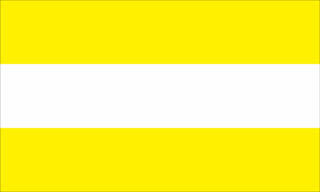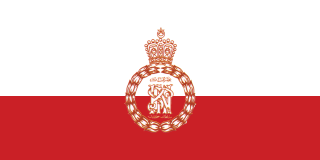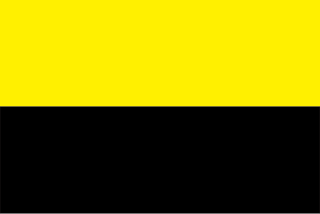
The Sultanate of Serdang was an early modern Malay-Indonesian monarchy, Serdang was founded in 1723 and joined the Republic of Indonesia in 1946. The Sultanate separated from the Sultanate of Deli after a dispute over the royal throne in 1720. Like other kingdoms on the east coast of Sumatra, Serdang prospered due to the opening of tobacco, rubber and oil palm plantations.
Adi 'Abd al-Majid ibn al-Marhum Panembahan Ismail, Panembahan Kusuma Negara III was the Panembahan of the Sintang traditional state 1905 – 1913. Ade Usman was born as the son of his predecessor Sri Paduka Tuanku Ismail, Panembahan Kusuma Negara II Panembahan of Sintang. His mother was his father's first wife Dayang Zainab, Ratu Permaisuri. His father soon appointed him as heir apparent. Assuming the throne following the death of his father on 22 December 1905, Usman was suspended from ruling in 1912 by the Netherlands East Indies authorities and was deposed by them on 16 January 1913 for "bad behavior" and exiled to Bogor in Java. He died on Java after that date.
Mantri is a word of Sanskrit origin, and it is used for a variety of public offices, from fairly humble to ministerial in rank. The term was used in various Asian cultures and eventually was used by early European traders. The term also forms part of a number of compounds. It is the root of the English word mandarin, for a bureaucrat of the Chinese empire.

The Sultan of Johor is a hereditary seat and the sovereign ruler of the Malaysian state of Johor. In the past, the sultan held absolute power over the state and was advised by a bendahara. Currently, the role of bendahara has been taken over by first minister with the constitutional monarchy system via Johor State Constitution. The sultan is the constitutional head of state of Johor. The sultan has his own independent military force, the Royal Johor Military Force. The sultan is also the Head of Islam in Johor state.

The Sultan of Perak is one of the oldest hereditary seats among the Malay states.
Tengku Ampuan Hajah Rahimah binti Almarhum Sultan Abdul Aziz Abdul Jalil Rahmat Shah was the Tengku Ampuan of Selangor, Malaysia during the reign of her husband, Sultan Salahuddin of Selangor.

This article lists important figures and events in Malaysian public affairs during the year 2002, together with births and deaths of notable Malaysians.
Sultan Salehuddin Shah ibni Almarhum Yamtuan Muda Riau II Opu Daeng Chelak was the first Sultan of Selangor. He was the son of the famous Bugis warrior prince Opu Daeng Chelak. He took on the title of Sultan Sallehuddin of Selangor in 1766. The Bugis had already begun to settle on the West coast of the Malayan Peninsula towards the end of the 17th century.

The Sultanate of Sambas was a traditional Malay state on the Western coast of the island of Borneo, in modern-day Indonesia.
Raja Yong Sofia binti Almarhum Sultan Azlan Muhibbuddin Shah Al-Maghfur-Lah is the fifth child of the Sultan of Perak, Sultan Azlan Shah. She holds a master's degree in Administration from International University in London. She worked for Bank Bumiputra.

The Sultan of Kelantan is the constitutional head of Kelantan state in Malaysia. The executive power of the state is vested in him as the monarch of the state. The current sultan, Muhammad V, is the 29th Sultan of Kelantan. He is the Head of Islam in the state and the source of all titles, honours and dignities of its people. He was the 15th Yang di-Pertuan Agong or the monarch and head of state of Malaysia from 13 December 2016 to his abdication on 6 January 2019, after his election on 14 October 2016 at the 243rd (special) Conference of Rulers.

Sultanate of Banjar or Sultanate of Banjarmasin was a sultanate located in what is today the South Kalimantan province of Indonesia. For most of its history, its capital was at Banjarmasin.
Tunku Dato’ Seri Nadzaruddin ibni Almarhum Tuanku Ja’afar is the third son and (youngest) of Tuanku Jaafar of Negeri Sembilan.

Tanjungpura Kingdom or Tanjompura was the name of an ancient 8th century kingdom that was located along the southwestern coast of Borneo facing the Java Sea, a region that today corresponds to the Ketapang Regency of West Kalimantan province of Indonesia. The kingdom experienced several moves of the royal capital, first located in Negeri Baru Ketapang Regency, then moved to Sukadana, since Rajanya Sorgi embraced Islam.

The Al-Ghufran Royal Mausoleum is a Royal Mausoleum of Perak located near Ubudiah Mosque at Bukit Chandan in Jalan Istana, Kuala Kangsar, Malaysia. The first Sultan of Perak buried here was Sultan Idris Murshidul Azzam Shah I in 1916.

The Mempawah Kingdom also known as the Mempawah Sultanate, was an Islamic Dayak kingdom located in a territory now known as the Mempawah Regency, West Kalimantan, Indonesia. The name Mempawah is taken from the term "Mempauh", which is the name of a tree that grows in the upper reaches of the river, also known as the Mempawah River. In its development, Mempawah became known as the name of one of the kingdoms and sultanates that developed in West Borneo. The history of Mempawah is divided into two periods, namely the Dayak kingdom based on Hindu teachings and the period of Islamic influence.
This page is based on this
Wikipedia article Text is available under the
CC BY-SA 4.0 license; additional terms may apply.
Images, videos and audio are available under their respective licenses.










